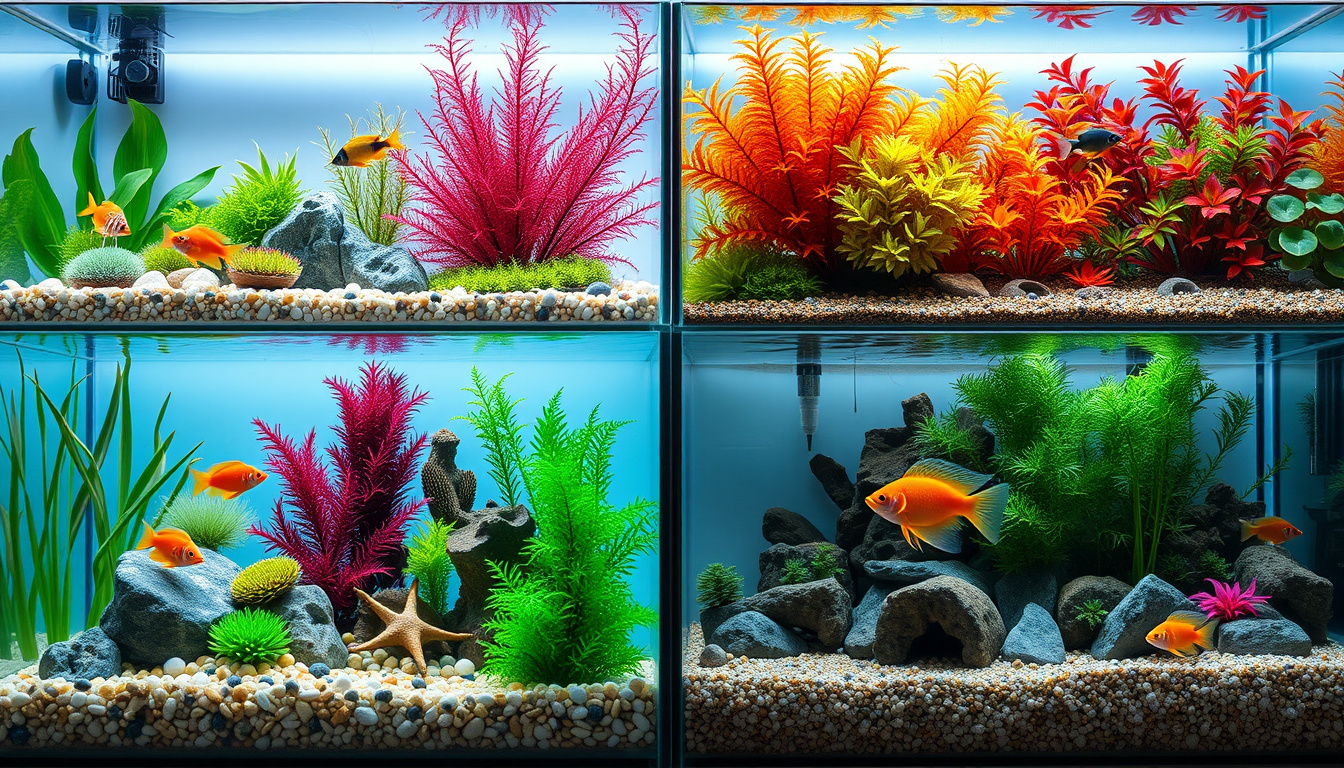If you’re ready to dive into the world of aquariums, one of the first big decisions you’ll face is choosing the best aquarium substrate for your tank.
Whether you’re setting up a vibrant freshwater ecosystem or a stunning saltwater haven, the right substrate can make all the difference.
In this complete guide, we’ll explore the various types of aquarium substrates, key factors to consider when making your choice, and tips for maintaining your substrate to keep your aquatic friends happy and healthy.
Ready to get started?
Let’s uncover all there is to know about aquarium substrate!

![Factors to Consider When Choosing<b> Aquarium Substrate</b>‘ style=’display: block; margin: auto; max-width: 100%; height: auto;’></p>
<h3>Factors to Consider When Choosing<b> Aquarium Substrate</b></h3>
<p>Choosing the right<b> aquarium substrate</b> can significantly impact the health and aesthetic appeal of your aquatic environment.</p>
<p><b>Aquarium substrate</b> comes in various types, each designed to cater to specific needs.</p>
<p>One major factor to consider is the type of aquarium you have—freshwater or saltwater—since this will influence your substrate choice.</p>
<p>For freshwater tanks, you might opt for gravel or sand, where each offers different benefits such as ease of cleaning and nutrient retention.</p>
<p>Conversely, if you’re setting up a planted aquarium, a nutrient-rich substrate can promote plant growth and enhance the overall ecosystem.</p>
<p>Another important consideration is the size of the substrate; smaller grains may encourage beneficial bacteria but can also trap debris, while larger grains may allow better flow but don’t support plant life as well.</p>
<p>Additionally, think about the aesthetic appeal—is your goal a natural look or something more vibrant?</p>
<p>Finally, don’t forget to consider the behavior of your fish; species that dig, for example, might prefer sand over gravel.</p>
<p>By weighing these factors carefully, you can select an<b> aquarium substrate</b> that not only meets your tank’s requirements but also enhances the beauty of your underwater world.</p>
<h3>Maintenance and Care of<b> Aquarium Substrate</b></h3>
<p>Taking care of your<b> aquarium substrate</b> is an essential part of maintaining a healthy aquatic environment for your fish and plants.</p>
<p>The term ‘aquarium substrate’ refers to the material that lines the bottom of your tank, which can include sand, gravel, or more specialized substrates designed for planted tanks.</p>
<p>Proper maintenance of the<b> aquarium substrate</b> not only keeps your tank looking pristine but also contributes to water quality and the overall health of your aquatic ecosystem.</p>
<p>To care for your<b> aquarium substrate</b> effectively, start by regularly vacuuming it during water changes to remove debris and excess nutrients that can cause problems like algae blooms.</p>
<p>Depending on the type of substrate you use, you may also need to consider the specific needs of your tank inhabitants—such as providing a softer substrate for bottom-dwelling fish or nutrient-rich options for live plants.</p>
<p>By keeping your<b> aquarium substrate</b> clean and well-maintained, you’ll create a thriving habitat that both you and your aquatic pets will enjoy!</p>
<h2>Frequently Asked Questions</h2>
<h3>What is<b> aquarium substrate</b> and why is it important?</h3>
<p>Aquarium substrate is the material used at the bottom of an aquarium to provide support for aquatic plants and decorations, as well as to facilitate beneficial bacteria growth.</p>
<p>It plays a crucial role in maintaining water quality and the overall health of the tank.</p>
<h3>What are the different types of substrates for freshwater tanks?</h3>
<p>Common substrates for freshwater tanks include gravel, sand, and specialized planted tank substrates.</p>
<p>Each has its own advantages depending on the type of fish and plants you wish to keep.</p>
<h3>Can I use the same substrate for both freshwater and saltwater tanks?</h3>
<p>No, it’s not recommended to use the same substrate for both types of tanks.</p>
<p>Saltwater substrates, such as aragonite, are specifically designed to maintain the appropriate pH and hardness levels for marine life, while freshwater substrates may not meet these requirements.</p>
<h3>What factors should I consider when choosing an<b> aquarium substrate</b>?</h3>
<p>Consider the type of fish and plants you want to keep, the substrate’s grain size, chemical properties, and ease of maintenance.</p>
<p>Additionally, think about the aesthetics and how it will complement your tank’s overall design.</p>
<h3>What are some common mistakes to avoid when selecting<b> aquarium substrate</b>?</h3>
<p>Some common mistakes include choosing the wrong type of substrate for the specific tank environment, using a substrate that is too coarse or too fine, and not rinsing the substrate before adding it to the tank, which can lead to cloudiness.</p>
<p>[center][/center]<br />[center][color=rgb(10, 10, 10)][highlight=rgb(255, 248, 231)] [/highlight][/color]<em>[color=rgb(10, 10, 10)][highlight=rgb(255, 248, 231)]As an Amazon Affiliate,[/highlight][/color]</em>[color=rgb(10, 10, 10)][highlight=rgb(255, 248, 231)] [/highlight][/color]<em>[color=rgb(10, 10, 10)][highlight=rgb(255, 248, 231)]Savvy Keto makes a commission[/highlight][/color]</em>[color=rgb(10, 10, 10)][highlight=rgb(255, 248, 231)] [/highlight][/color]<em>[color=rgb(10, 10, 10)][highlight=rgb(255, 248, 231)](at no extra cost to you)[/highlight][/color]</em>[color=rgb(10, 10, 10)][highlight=rgb(255, 248, 231)] [/highlight][/color]<em>[color=rgb(10, 10, 10)][highlight=rgb(255, 248, 231)]on purchases you make[/highlight][/color]</em>[color=rgb(10, 10, 10)][highlight=rgb(255, 248, 231)] [/highlight][/color]<em>[color=rgb(10, 10, 10)][highlight=rgb(255, 248, 231)]thru links on this site.[/highlight][/color]</em>[/center]</p>
</div></div>
</div>
<div class="wp-block-column is-layout-flow wp-block-column-is-layout-flow" style="flex-basis:33.33%">
<div class="wp-block-group sidebar-area-wrap is-layout-constrained wp-container-core-group-is-layout-5a30f31b wp-block-group-is-layout-constrained">
<div class="wp-block-group has-border-color has-cyan-bluish-gray-border-color is-layout-constrained wp-container-core-group-is-layout-d17736d3 wp-block-group-is-layout-constrained" style="border-width:1px;margin-bottom:var(--wp--preset--spacing--60);padding-top:var(--wp--preset--spacing--50);padding-right:var(--wp--preset--spacing--50);padding-bottom:var(--wp--preset--spacing--50);padding-left:var(--wp--preset--spacing--50);box-shadow:var(--wp--preset--shadow--natural)">
<h3 class="wp-block-heading has-medium-font-size" style="margin-bottom:var(--wp--preset--spacing--50)">Search Here</h3>
<form role="search" method="get" action="https://axolotlqs.com/" class="wp-block-search__button-outside wp-block-search__icon-button wp-block-search" ><label class="wp-block-search__label screen-reader-text" for="wp-block-search__input-3" >Search</label><div class="wp-block-search__inside-wrapper " ><input class="wp-block-search__input" id="wp-block-search__input-3" placeholder="" value="" type="search" name="s" required /><button aria-label="Search" class="wp-block-search__button has-text-color has-foreground-color has-background has-icon wp-element-button" type="submit" style="background-color: EE344E"><svg class="search-icon" viewBox="0 0 24 24" width="24" height="24">
<path d="M13 5c-3.3 0-6 2.7-6 6 0 1.4.5 2.7 1.3 3.7l-3.8 3.8 1.1 1.1 3.8-3.8c1 .8 2.3 1.3 3.7 1.3 3.3 0 6-2.7 6-6S16.3 5 13 5zm0 10.5c-2.5 0-4.5-2-4.5-4.5s2-4.5 4.5-4.5 4.5 2 4.5 4.5-2 4.5-4.5 4.5z"></path>
</svg></button></div></form></div>
<div class="wp-block-group has-border-color has-cyan-bluish-gray-border-color has-primary-color has-text-color has-link-color wp-elements-273765fa493b75186c730259594551ae is-layout-constrained wp-container-core-group-is-layout-cd68c28b wp-block-group-is-layout-constrained" style="border-width:1px;margin-bottom:var(--wp--preset--spacing--40);padding-top:var(--wp--preset--spacing--50);padding-right:var(--wp--preset--spacing--50);padding-bottom:var(--wp--preset--spacing--50);padding-left:var(--wp--preset--spacing--50);box-shadow:var(--wp--preset--shadow--natural)">
<h3 class="wp-block-heading has-medium-font-size" style="margin-bottom:var(--wp--preset--spacing--50)">Categories</h3>
<ul style="margin-top:var(--wp--preset--spacing--30);margin-bottom:var(--wp--preset--spacing--30);" class="wp-block-categories-list wp-block-categories"> <li class="cat-item cat-item-16"><a href="https://axolotlqs.com/category/axolotl-care/">Axolotl Care</a> (1)
</li>
<li class="cat-item cat-item-1"><a href="https://axolotlqs.com/category/uncategorized/">Uncategorized</a> (74)
</li>
</ul></div>
<div class="wp-block-group has-border-color has-cyan-bluish-gray-border-color has-primary-color has-text-color has-link-color wp-elements-d412829f01410d17dfe33d1ef5354d19 is-layout-constrained wp-container-core-group-is-layout-cd68c28b wp-block-group-is-layout-constrained" style="border-width:1px;margin-bottom:var(--wp--preset--spacing--40);padding-top:var(--wp--preset--spacing--50);padding-right:var(--wp--preset--spacing--50);padding-bottom:var(--wp--preset--spacing--50);padding-left:var(--wp--preset--spacing--50);box-shadow:var(--wp--preset--shadow--natural)">
<h3 class="wp-block-heading has-medium-font-size" style="margin-bottom:var(--wp--preset--spacing--50)">Archives</h3>
<ul class="wp-block-archives-list wp-block-archives"> <li><a href=](https://im.runware.ai/image/ws/2/ii/c8afa108-404f-4629-94e8-51933e717284.jpg) October 2025
October 2025

